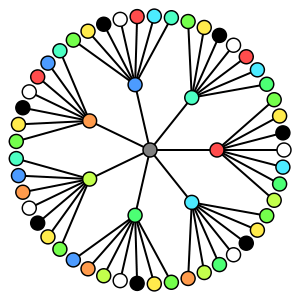Harmonious coloring

Harmonious coloring of the complete 7-ary tree with 3 levels using 12 colors. The harmonious chromatic number of this graph is 12 since
Any fewer colors will result in a color pair appearing on more than one pair of adjacent vertices. Moreover, by Mitchem's Formula, χH(T7,3) = ⌈(3/2)(7+1)⌉ = 12.
In graph theory, a harmonious coloring is a (proper) vertex coloring in which every pair of colors appears on at most one pair of adjacent vertices. The harmonious chromatic number χH(G) of a graph G is the minimum number of colors needed for any harmonious coloring of G.
Every graph has a harmonious coloring, since it suffices to assign every vertex a distinct color; thus χH(G) ≤ |V(G)|. There trivially exist graphs G with χH(G) > χ(G) (where χ is the chromatic number); one example is the path of length 2, which can be 2-colored but has no harmonious coloring with 2 colors.
Some properties of χH(G):
- , where Tk,3 is the complete k-ary tree with 3 levels. (Mitchem 1989)
Harmonious coloring was first proposed by Harary and Plantholt (1982). Still very little is known about it.
See also
External links
- A Bibliography of Harmonious Colourings and Achromatic Number by Keith Edwards
References
- Frank, O.; Harary, F.; Plantholt, M. (1982). "The line-distinguishing chromatic number of a graph". Ars Combin. 14: 241–252.
- Jensen, Tommy R.; Toft, Bjarne (1995). Graph coloring problems. New York: Wiley-Interscience. ISBN 0-471-02865-7.
- Mitchem, J. (1989). "On the harmonious chromatic number of a graph". Discrete Math. 74: 151–157. doi:10.1016/0012-365X(89)90207-0.
This article is issued from Wikipedia - version of the 7/7/2016. The text is available under the Creative Commons Attribution/Share Alike but additional terms may apply for the media files.